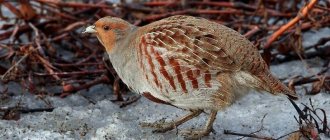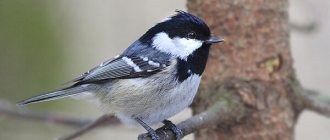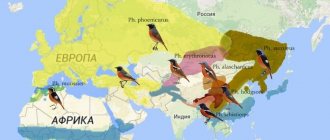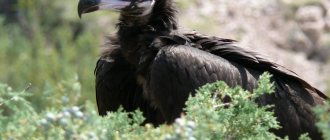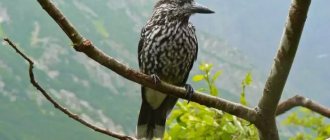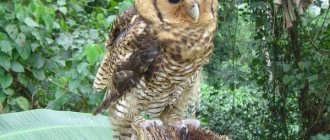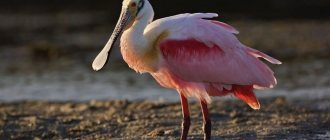Description and features
The rock partridge or chukar is a small bird compared to its older cousins, the pheasants. The body length does not exceed 40cm, the weight rarely reaches 900g, in most cases it varies around half a kilogram. The wingspan is about half a meter.
The voice of the chukar can be heard in the morning twilight, when the males arrange a “roll call”. It sounds like “ke-ke-lik”. It is called the stone mountain partridge for its resemblance to the bird and its predominant habitat.
The soil and steppe vegetation determined the color of the species. The vast majority of chukar feathers are of various shades of sandy. Gray creates shadows. Pink and blue lightly dilute the dull plumage. The head is much more colorful than the body: yellow cheeks and throat, delimited by an expressive black line, orange feathers around the ears.
A wine-colored drop adorns the front of the back. Red rings highlight the eyes. The belly of the chukar is colored light ocher; the tail includes bright reddish feathers, but they are visible only when flying. Males have spurs on their legs. looks beautiful in the photo It complements the distinctive landscape of the mountain steppe with bright feathers.
How to distinguish a male from a female
Up to 4 months, it is impossible to distinguish a male from a female in a chukar. At 4 months, males become clearly larger, and a pink spot appears on the metatarsus - the place where the spur will appear. At 5 months the color changes slightly. Males have 11 stripes on their sides, females have 9-10.
Advice! If a male closely resembles a female, he should be removed from the breeding herd. This is an underdeveloped bird that is not capable of producing offspring.
But it is guaranteed that the sex of the bird can be determined when the males begin to breed.
Types of chukars
Partridge chukar is a rather variable bird. There are about 20 different species around the globe! Differentiation is mainly related to the area in which the birds live. Outwardly little expressed. Let's look at a few of the most common types.
Asian chukar
The Asian chukar is the most common bird species. Most often, it is its description that is used as a canon for the entire species, and is simply called chukar. The Asian chukar has the largest distribution area: from the Caucasus to the Pamirs. This fact determines the popularity of the bird for keeping in captivity.
Keklik Przhevalsky
Przewalski's chukar is otherwise called the Tibetan mountain partridge. Nowadays, it is not easy to find the chukar in Tibet. Its main habitat is the ridges in Qinghai Province. It is not difficult to distinguish it from the Asian chukar: the color of the feathers shows, there is no black stripe on the neck.
The European partridge is practically no different from the most common species. To differentiate birds, you will have to work hard, carefully looking and listening to individuals. Not only the plumage reveals their differences, each species has its own dialect.
The red partridge lives on the Iberian Peninsula. It got its name for a reason. It is determined by the color of the plumage. The British government banned the mixing of the Asian partridge and the red partridge in 1992 to preserve the latter species as a national treasure.
Arabian chukar
The Arabian chukar lives, as the name of the species suggests, on the Arabian Peninsula. The second name of this species is black-headed chukar. It is not accidental. The most striking difference from other species of mountain partridge is the black cheeks and crown
Nutrition
The Asian rock partridge, which is bred by many poultry farmers, feeds on food of plant origin. She likes to eat berries and fruits, buds, grains, and greens. The Asian chukar also produces various bulbs from the ground. A small part of a bird's daily diet consists of insects and other food of animal origin - such as beetles, caterpillars, and spiders.
Winter is a difficult period of the year for birds, as snow cover makes movement difficult and food inaccessible. Therefore, chukars fly at this time to the southern slopes, where there is less snow, and then descend to the plains. When snowy winters occur, a large number of birds die due to lack of food.
All subspecies of chukars are similar in their lifestyle. In the morning they take roll call, then go in search of food and water. With the onset of the heat of the day, they prefer to swim in the sand and relax. In the evening they fly out again to get food and go to the water. In case of danger, they begin to quickly run away, then fly low above the ground and rush in different directions.
Lifestyle and habitat
The mountain chukar is an unpretentious bird, therefore it is distributed over vast territories from the Balkan Peninsula to China. The species is adapted to the conditions of America, New Zealand, and Hawaii. After disappearing in Crimea, it was reintroduced to the peninsula. Chukars were adapted for game.
You may notice that the chukar lives in warm steppe and mountainous regions. Therefore, it is not surprising that the chukar prefers to settle in mountains, gorges, canyons and various slopes. Stone partridges often make their homes at high altitudes compared to sea level.
Values can approach 4500m! Therefore, you can find chukars high in the mountain steppes. However, birds try to avoid areas with high air humidity, so you will not find these birds in the tundra or alpine meadows at such an altitude.
The lifestyle of rutting stone partridges is sedentary. Only once a year do flocks migrate, and then only in a vertical direction. Flights are also made in case of danger. A whole flock, screaming, flies up and moves to the next hill. Chukars do not always flee for their lives. They can be protected by plumage, which blends perfectly with steppe grass, sand, clay, wood and rocks.
Chukars follow a daily routine. Early in the morning they go out to feed and explore the slopes. Closer to noon, the whole flock sets off on foot to drink. During the hottest hours of the day, they rest in shady places. After the “quiet hour”, it is time for watering again, and is replaced by dinner, which lasts until sunset.
The diet includes bulbs, grasses, berries, caterpillars, ants and other insects. Winter is hard for chukars. Plant food is difficult to obtain from under the snow, which chukars eat to replenish their water balance.
As you know, snow storms and drifts are common in the mountains. For rock partridges, such an event may be the last. Birds find shelter and sit in it for several days. In cases where frost hits after a snowstorm, they are completely deprived of food, lose weight in a matter of days and die. The population recovers within a couple of seasons thanks to large clutches of eggs.
Chukars have many enemies. Reptiles, birds of prey and mammals are not averse to feasting on small birds, which are not so difficult to catch due to their terrestrial lifestyle. Most often, stone partridges fight off foxes, martens, steppe cats, golden eagles and hawks. The winter enemy is frost. If the birds do not gather together to keep each other warm, they will not survive the winter night.
Chukars like to settle near populated areas. Weeds often form part of the food supply. Abandoned buildings provide shelter from wind, cold and predators. They do not sit on branches, but move on foot or run along slopes. This makes them similar to lancers, brothers in the pheasant family.
Raising chicks
After the chicks hatch, they are shelled and placed in a warm cage or box. The best option for successfully raising chicks is a brooder. It allows you to minimize the mortality of chukars at an early age.
They try to maintain an optimal temperature in the cage; in the first weeks of life it is about 35 °C. It is very simple to understand how the chicks feel: if they huddle together and are cold, it is worth increasing the heating. An infrared lamp must be installed in the cage; it allows you to perfectly heat the cage and regulate the temperature in it.
At the age of five months, chukars know their owner and home very well. Now they can be transferred to free range.
Reproduction and lifespan
The domestic chukar lives quite a long time - up to 20 years. In nature, life expectancy is reduced significantly by strict natural selection. However, the overwhelming majority of representatives are monogamous; exceptions are found among old males.
The breeding season begins in the first year of life. Large broods contribute to the spread of the species, provided that birds are constantly hunted. In the spring, the friendly flock breaks up: each bird is looking for a mate. Males perform “dances” and make sharp guttural sounds.
They flap their wings to attract females. Chukar nests are made in areas protected by vegetation from attack by predators. Favorite nesting places are closer to water bodies. Water is an important component of the life support of these birds. Nests are small holes dug in the ground. Their depth is about 4 cm, sometimes reaching 9 cm, and their diameter is about 30 cm.
A clutch can contain from 7 to 21 eggs. There are cases when the first clutch of the season is hatched by the female, and the second by the male. Broods most often unite under the guardianship of a female, but they can also separate. Cases have been observed when several broods united, and not one pair, but several adult birds took care of them.
Mountain partridges grow and develop quickly. A few hours after hatching, the chick can independently follow the adult. After 3-4 months, he is no different from his older relatives. The chicks' diet consists of protein foods. Caterpillars and bugs supply them with the necessary substances for rapid development and weight gain.
Where to begin?
By and large, anyone who has at least a small utility room can start breeding and keeping partridges at home. If you wish, you can even set up this business in a garage, although a country house with two dozen acres of adjacent land would, of course, be better for these purposes.
The first thing any commercial project begins with is drawing up a clear business plan. Before purchasing building materials for a chicken coop and looking for poultry suppliers, you should carefully calculate all costs, find out how to sell finished products and current prices for them. Only after making sure that the project will be profitable under current circumstances can you begin to create a farm.
Since not many enterprises are engaged in breeding partridges in Russia (which, in fact, is good, because the competition will be low), you may have to go to another region several hundred kilometers to get the first batch of young animals. It is better to purchase several pairs (unlike most poultry, partridges are monogamous), having received offspring from which in the future it will be possible to form the required number of livestock.
Usually, at the start, 4-5 pairs of adult partridges are purchased, but you can purchase chicks or even eggs. Purchasing adult birds carries less risk, although it will cost much more. On the other hand, an entrepreneur with extensive experience in poultry breeding can safely start with incubation.
Breeding chukars at home
Keklik is essentially nothing more than an undomesticated chicken. Therefore, its maintenance is no more difficult than providing for chickens. Many farms practice chukar breeding . At the same time, partridges do not get along with other species of birds: one species of chicken or pheasant begins to beat the other.
Chukars actively interact with people. They are not only hunted. Mountain partridges are kept for fun: they decorate houses or fight in bird arenas. In Tajikistan, the chukar can become the property of an entire village!
The difficulty of breeding chukars is that the females do not sit on eggs in the cage. Chicks can only be hatched using an incubator. A chukar egg can be stored for incubation for as long as three weeks! During this time, you can select high-quality eggs, without cracks.
The eggs are placed in the incubator for approximately 25 days. Periodically it is necessary to change the humidity and air temperature conditions. Immediately after hatching, the chicks are active, so they are visited in a special brooder, which maintains a relatively high temperature - about 35C.
The conditions in the brooder can be easily adjusted by monitoring the partridges. Since representatives of this species have a rather bad character, they prefer to stay away from each other. Therefore, the situation when the chicks huddle together should arouse suspicion - this means the chicks are cold, it is necessary to increase the temperature.
As they grow up, chukars often get into fights. To prevent such events in bird life from causing damage, it is necessary to follow the rule for keeping chicks: for 10 individuals - a quarter of a square meter. If space allows, you can even keep different broods in one pen!
Young chukars bred in captivity, like their free-ranging relatives, need protein of animal origin. In nature reserves where birds are bred for subsequent release into the wild, the chicks are fed insects: grasshoppers, beetles and caterpillars.
This is impossible at home and in poultry farms. Therefore, poultry farmers include broiler feed and bone meal in the diet. It is still recommended to feed the individuals with insects, after removing all the hard parts: wings and legs.
Meaning for humans
Birds actively interact with humans. Increasingly, they are becoming prey for hunters and objects of interest for poultry farmers.
People catch birds for tasty meat and to diversify their aviary with interesting representatives of the pheasant family. Moreover, chukars get along with chickens and quails, but they feel uncomfortable and are constantly bullying.
The bird is not picky about care and feeding. Features of its content include:
- feeding three times a day at the same time;
- a large amount of protein in the diet;
- balanced diet.
Each cage should have a feeder, a drinker, and a hay barn for food.
Birds are well tamed. They are strongly attached to their owner and willingly follow him around the property or house.
Hunting for chukar
Chukars are mainly caught using snares. Hunting with a gun is less common. Fans of firearms hunting use a special camouflage shield called a chordak.
The device is made from burlap stretched over crossed sticks. Black circles are drawn on the shield, chukar feathers and skins of other game are attached. Chordak helps the hunter get as close as possible to the chukars. Without the use of a device, a successful hunt for chukar is unlikely, because chukars are shy.
To summarize, we can say that the chukar or mountain partridge is an amazing bird. She is beautiful, badass, careful and smart and meaty. The totality of all its qualities determines the way of life and behavioral characteristics, without which individuals cannot survive in nature, where predators, birds, humans, and weather create great difficulties.
Security
There has been a long-term decline in European chukar numbers: this negative trend appears to have spread from east to west in the Alps since the early 1950s. There are many reasons for this: reduction of cultivated land, desolation of alpine meadows and high mountain pastures, overgrazing of small livestock, epidemic diseases, poaching. At one time, attempts were made to massively increase this species for commercial purposes, for which individuals of dubious genetic purity and another species of chukar (Alectoris chukar) (sometimes considered subspecies) were used, which only led to an even greater deterioration of the situation.
Are you here
Sopyev O.S., Mukhiev R.Kh., Shkolnaya E.A.
Experience in keeping and breeding chukar chukar in Turkmenistan // First All-Union Meeting on Problems of Animal Culture. Abstracts of reports. Part two. Moscow, 1986. pp. 78-79. EXPERIENCE OF KEEPING AND BREEDING KEKLIK IN TURKMENISTAN
Within the scope of scientific research of the industrial research laboratory for the protection and use of wildlife of the Turkmen Agricultural Institute in 1983-1986. For the first time, work was carried out on breeding chukar chukar in enclosure conditions in the vicinity of Ashgabat. A pair of chukars, kept in the nursery's enclosures since 1983, was noted to reproduce in the spring of 1984. Oviposition was interrupted due to construction work near the enclosure. The first breeding stock was created in 1984 from 16 eggs taken from natural chukar chukar clutches in the Central Kopetdag. For incubation of eggs, an IPH-5 incubator was used with a temperature regime of 37.0-38.0 ° C and a humidity of 80-100 $. In 1985, a separate group (2 males and 5 females) was created from first-year chukars raised in captivity, which was kept in an enclosure connected to a closed room (Bruderhaus). The design of the brooder allows the birds to receive insolation in the morning and evening hours and avoid overheating during the hot part of the day. The first eggs in 1985 were laid in the first ten days of April. The egg laying lasted 2 months. The last eggs are laid in the third ten days of June. A total of 78 eggs were laid by five females, 15.7 eggs per female. Egg fertilization was 91.6%. The total duration of egg incubation is 21-23 days. Hatchability based on the number of fertilized eggs is 93.9%. In mid-March 1986, 2 groups of chukars were formed for breeding, consisting of males and females in a ratio of 1:2 and 1:3. The first group consisted of first-year birds (5 males and 10 females) in an aviary with an area of 24 m2; the second is from old individuals that bred in 1985 (2 males and 6 females) in an enclosure with an area of 18 m2. Oviposition in “old” birds (second group) lasted from April 7 to the end of June, in young birds (first group) from April 14 to the end of May. The productivity of “old” females was 25.8 per hen, and that of young females was 5.8. Intra-group relations between the young were marked by instability; they often experienced conflicts, pecking and oppression of individual individuals. This apparently influenced the results of oviposition. Chukar chicks up to 15-20 days of age were kept in brooder boxes with local heating. Then they transferred to the Broederhaus. At an early age, the chicks were fed egg-curd mash with the addition of poultry feed, insects, grain mixtures, meat and bone meal, and vitamin preparations (Biovit-80, Trivit, methionine, potassium permanganate solution). A constant component of the feed is fresh alfalfa, gravel, and ground shells. Young chukars demonstrated pronounced gregarious behavior. The chicks fed together, drank, bathed in the sand, hid in the shade, and settled down to rest, usually all at the same time. Birds kept in a nursery for more than a year become well accustomed to the conditions of captivity. During the reproductive period, males showed aggression towards humans. The success of keeping and breeding chukars was facilitated by the implementation of veterinary and preventive measures: disinfection with solutions of chlorophos (1%), caustic sodium (1-2% in enclosures without birds), the creation of creolin disinfection barriers and disinfection mats at the entrance to the farm territory and enclosures, burning a soldering iron lamp on the surface of the floor, border and walls; fumigation of eggs in steam-formal guide; prevention of coccidiosis (coccidiovitis), pullorosis (furazolidone), heterokidosis (tetramizole or piperazine); vaccination of Newcastle disease (bird plague) by drinking La Sota solution. The results of experimental work show that the cultivation and breeding of chukar chukar under artificial conditions can be carried out on a large scale, subject to the necessary set of housing and feeding conditions. The raised offspring can be used to enrich hunting grounds, resettlement, meet the needs of zoos, etc.
Giant mountain frog or mountain chicken
The giant mountain frog (Leptodactylus fallax), also known as the mountain hen or mountain chicken, is a species of frog found on just two Caribbean islands - Dominica and Montserrat.
The mountain chicken is the largest of all living Leptodactylus species, and is one of the largest species of living frogs. The body length of these amphibians can reach more than 20 cm, weight more than 900 g. Life expectancy in natural conditions is about 12 years. Males differ from females in smaller size.
Due to their powerful, fleshy hind legs, local residents gave these frogs the name mountain chicken. With their striking dark stripes and spots, giant mountain frogs are effectively camouflaged on the forest floor when they are not hiding in burrows or crevices. Their color varies greatly, ranging from dark brown to light chestnut. The color becomes orange-yellow on the sides and almost white on the belly.
lBNEOOBS LHTPRBFLB YMY LELMYL
rFYGB Utedoek CHEMYYYOSCH Y CHEUSHNB RMPFOPZP UMPTSEOYS, DPUFYZBAEBS CHUB PF 300 DP 700 ZTBNNNPCH. PE CHUEI NEUFBI PVYFBOYS POB SCHMSEFUS PUEDMPK RFYGEK.
h uoz PVYFBEF 9 RPDCHYDPC LBNEOOPK LHTPRBFLY, LPFPTSCHE OEOBYUYFEMSHOP PFMYUBAFUS DTHZ PF DTHZB TBNETBNY, PLTBULPK PRETEOYS Y NEUFBNY PVYFBOYS. pDOBLP PTOYFPMPZY o. b. ZMBDHR, Fr. O. lBTFBYECH, u. part nYIEECH UYYFBAF HUMPCHOPK UKHEEUFCHHAEHA TBVYCHLH LELMYLPCH ABOUT RPDCHYDSCH.
h OBUFPSEEE CHTENS RTY'OBAFUS UMEDHAEYE RPDCHYDSCH LBNOOOPK LHTPRBFLY: LBCHLBULYK LELMYL, PVYFBAEIK CH ZPTBI lBCHLBBYY BLLMYINBFYYTPCHBOOSCHK CH ZPTBI lTSCHNB; LPREFDBZU-LYK LELMYL, PVYFBAEIK ZMBCHOSCHN PVTBЪPN CH ZPTBI fHLNEOYY; ЪBRBDOPFHTLNEOULYK TBCHOOOSCHK LELMYL, PVYFBAEIK CH VKHZTYUFSHI REULBI, ABOUT OEVPMSHYI ZMYOYUFSHCHI IPMNBI Y ABOUT PFDEMSHOSHI ZPTOSHI KHUBUFLBI RKHUFSCHOOSHHI TBCHOYO ЪBRBDOPK fHTL NEOY; CHPUFPYUOPYTBOULYK LELMYL, CHUFTEYUBAEIKUS H OBU CH PZTBOYUEOOOPN LPMYUEUFCHE CH PFOPUIFEMSHOP VEMADOSCHI TBKPOBI UTEDOEK BYYY; LSHCHSMLKHNULYK LELMYL, FSOSH-YBOSHULYK LELMYL, LBTBLHNULYK LELMYL, DTSKHOZBTULYK LELMYL Y LBIZBTULYK LELMYL, PVYFBAEYE CH ZPTOSCHI TBKPOBI fHTTLNEOYY, fBDTSYLYUFBOB, hЪVELYUFBOB, lYTZYYYY lBBIUFBOB.
h PLTBULE PRETEOYS LBNEOOPK LHTPRBFLY RTEPVMBDBAF UETCHE Y PITYUFSHCH FPOB, NEUFBNY U VHTPCHBFSHCHN TPЪPCHP-CHIOOSCHN Y ZPMHVPCHBFSHCHN PFFEOLBNY. x CHUEI RPDCHYDPCH LBL X UBNGPC, FBL Y X UBNPL PFP MVB YUETE ZMBY DBMEE RP VPLBN ZPMPCHSH RTPIPDIF STLP CHSTBTSEOOBS YuETOBS RPMPUB, LPFPTBS ЪB KHYBNY URKHULBEFUS RP VPLBN YEY CHOY Y UPEDIOSEFUS ABOUT OITSOEK YUBUFY YEY CHYDE PTSETEMSHS.
Partridges in the yard raising miniature gray birds
La 3:52).
There is much debate over the words of Jeremiah 17:11, which says that a person who “gets rich by dishonest means is like a partridge that gathers up what it has not laid aside.” Some ancient authors wrote that the partridge steals eggs from other people's nests and incubates them, but modern naturalists believe that this cannot be said about any species of partridge. However, there is a mention that the Jewish zoologist Israel Aharoni (1882-1946), writing about the animal world of Palestine, discovered “a nest in which two females laid eleven eggs each” (Koehler L., Baumgartner W. Lexicon in Veteris Testamenti Libros. Leiden, 1958, p. 851). In the “Jewish Encyclopedia” about (Encyclopaedia Judaica. 1973. Vol. 13. Stb. 156).
One translation of Jeremiah 17:11 reads: “The partridge sits on its eggs, but does not hatch any chicks. So is a person who gets rich dishonestly - in the prime of life he will lose everything, he will turn out to be a fool! (PSA). This verse is similarly rendered in the King James Version (KJ) of the Bible. Speaking in support of this translation option, Professor John Sawyer Fr. He goes on to say that the proof of the truth of the parable recorded at Jeremiah 17:11 “is not the cunning of the partridge sitting on its eggs, but its insecurity, comparable to the false sense of security that a fool feels when he believes that he can get away with his dishonesty and greed.” ... and unaware of the dangers that threaten him and how defenseless he is in the face of disaster” (Vetus Testamentum. Leiden, 1978. pp. 324, 328, 329).
